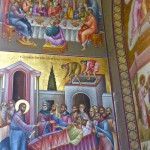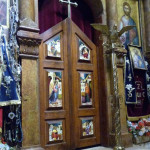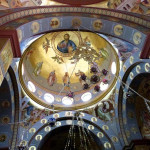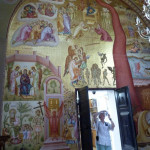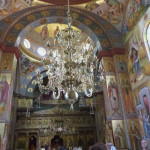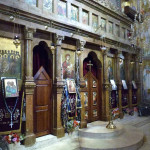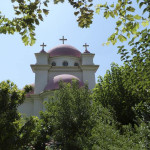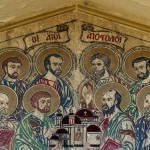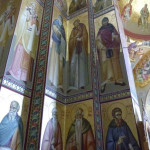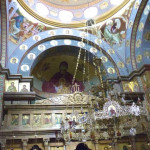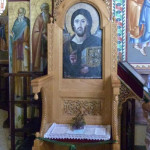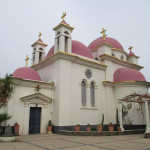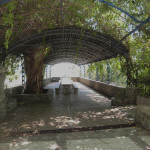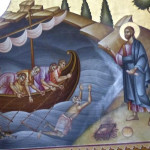Israel
The red-domed Greek Orthodox church on the edge of the Sea of Galilee at Capernaum has become an icon of the Holy Land, though it is more often photographed than visited.
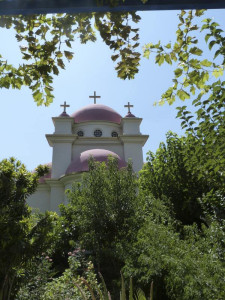
Lush greenery framing the Church of the Twelve Apostles (Seetheholyland.net)
The Church of the Twelve Apostles takes its name from the Gospel account of Jesus choosing the Twelve, an event that took place on a mountain in this area of Galilee.
But it is also known as the Church of the Seven Apostles — a reference to Jesus’ post-Resurrection appearance by the Sea of Galilee to seven of his disciples — Simon Peter, Thomas, Nathanael, James and John “and two other disciples” (John 21).
Jesus had made Capernaum his home town. The Church of the Twelve Apostles occupies a site to the east of ancient Capernaum, where survivors of a devastating earthquake in 749 relocated their village.
A small, cross-shaped building with white walls, the Church of the Twelve Apostles has two central domes surrounded by six smaller ones, each topped by a cross.
Built in 1931, it stands close to the shore, in a secluded haven of lush trees and gardens. Inside, the walls and ceilings are covered with impressive frescoes depicting biblical themes.
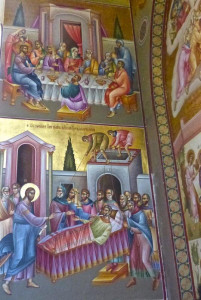
Gospel scenes in the Church of the Twelve Apostles (Seetheholyland.net)
Church was in no-man’s land
The Church of the Twelve Apostles is believed to stand on the site of a Byzantine church dedicated to St John the Theologian.
Capernaum had been in ruins for several centuries when the site was purchased by the Greek Orthodox Patriarchate of Jerusalem and the present church erected.
But following the 1948 Arab-Israeli War, the church found itself in a demilitarised zone between Israel and Syria.
Local Christians or pilgrims had no access to this no-man’s land, so the church and its adjacent monastery fell into decay, and Druze residents used the church as a barn.
After the Six Day War in 1969, when Israel pushed its border back to the Golan Heights, restoration of the church began with the removal of a thick layer of cow manure covering the floor.
Between 1995 and 2000 the church was redecorated by a Greek iconographer with an eclectic array of Byzantine-style frescoes inspired by works in Orthodox churches and monasteries in various parts of the world, in particular the Balkans.
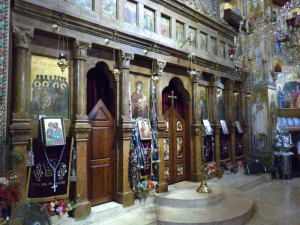
Stone iconostasis in the Church of the Twelve Apostles (Seetheholyland.net)
Striking fresco portrays Judgement Day
Brightly-coloured frescoes and icons cover most of the ceilings and walls of the church.
Inside one dome, Christ the Pantocrator (All-powerful) is surrounded by a chorus of 12 prophets who foretold his coming.
In the other dome, Christ is shown as an old man under the title of the Ancient of Days — a name for God from the Book of Daniel — and surrounded by 12 patriarchs.
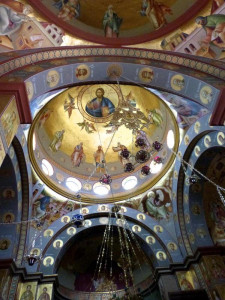
Christ the Pantocrator in a dome of the Church of the Twelve Apostles (Seetheholyland.net)
Other frescoes and icons depict the Crucifixion, the Resurrection, the Madonna and Child, saints who lived in the Holy Land and Galilean scenes from the Gospels — Jesus walking on the water, the calming of the storm, the miraculous catch of fish and the healing of the paralysed man.
The most striking fresco, a dramatic portrayal of Judgement Day, covers the back wall of the church as a reminder to departing faithful that they will be judged by what they do during their earthly lives.
It vividly conveys the contrast and tension between the glory of those who are saved (on the left of the fresco) and the horror of those who are damned (to the right). The two groups are separated by a river of fire leading down to hell.
Related site: Capernaum
In Scripture:
Jesus calls the Twelve Apostles: Luke 6:12-16
Jesus appears to seven disciples: John 21:1-14
Administered by: Greek Orthodox Patriarchate of Jerusalem
Tel.: 972 (0)4 6722282
Open: No regular hours, so before visiting check with the church or the patriarchate in Jerusalem, 972 (0)2 6282048
- Gospel scenes in the Church of the Twelve Apostles (Seetheholyland.net)
- Holy doors in the iconostasis in the Church of the Twelve Apostles (Seetheholyland.net)
- Christ the Pantocrator in a dome of the Church of the Twelve Apostles (Seetheholyland.net)
- Fresco of Judgement Day on the back wall of the Church of the Twelve Apostles (Seetheholyland.net)
- Elaborate chandelier in the Church of the Twelve Apostles (Seetheholyland.net)
- Stone iconostasis in the Church of the Twelve Apostles (Seetheholyland.net)
- Lush greenery framing the Church of the Twelve Apostles (Seetheholyland.net)
- The 12 apostles on the portal of the Church of the Twelve Apostles at Capernaum (Sergey Serous)
- Saints crowd the walls of the Church of the Twelve Apostles (Seetheholyland.net)
- Above the iconostasis, the Virgin and Child are surrounded by saints (Seetheholyland.net)
- An icon of Christ on the patriarch’s chair in the Church of the Twelve Apostles (Seetheholyland.net)
- The multi-domed Church of the Twelve Apostles (Avishai Teicher / Pikiwiki Israel)
- Shady terrace beside the Sea of Galilee at the Church of the Twelve Apostles (Seetheholyland.net)
- Christ saves Peter from drowning, in the Church of the Twelve Apostles (Seetheholyland.net)
References
Anonymous: The Monastery of the Twelve Apostles (Greek Orthodox Church leaflet, undated)
Freeman-Grenville, G. S. P.: The Holy Land: A Pilgrim’s Guide to Israel, Jordan and the Sinai (Continuum Publishing, 1996)
Rossing, Daniel: Between Heaven and Earth: Churches and monasteries of the Holy Land (Penn Publishing, 2012)

